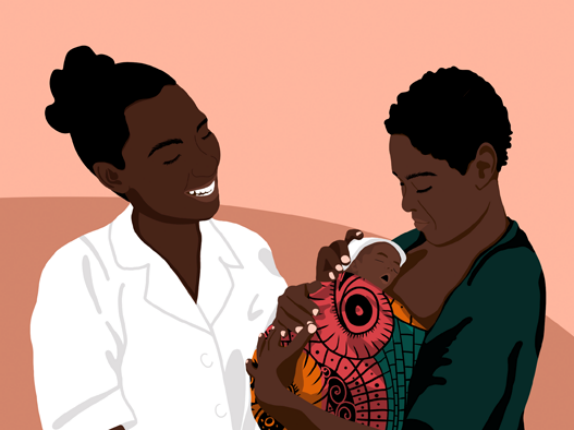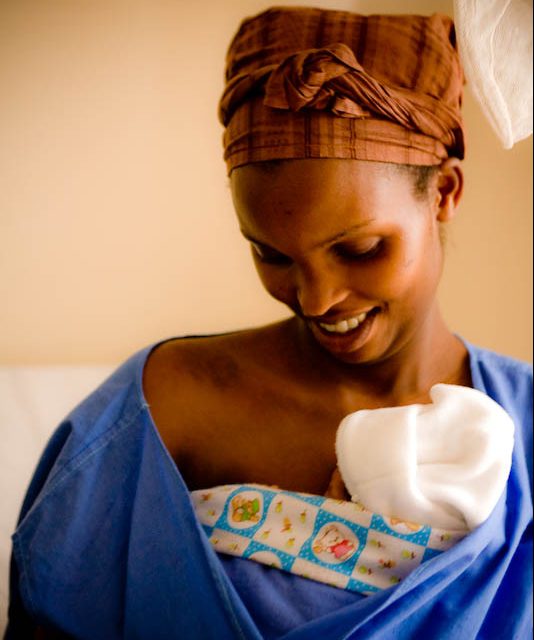Introduction and Background
Issue Overview
Every year, nearly 15 million babies are born prematurely. [1] Newborns who are born too early, too small, or who become sick in the first few weeks of life are extremely vulnerable to long-term disability or death. Preterm birth complications are the leading cause of death in children under five years of age, accounting for approximately one million deaths per year. It is estimated that three-quarters of these deaths can be prevented with existing, cost-effective interventions [2].
In a world that grapples with unprecedented challenges, from a global pandemic, to climate change, conflicts and instability, and growing wealth disparity, the birth of a healthy child often represents a uniquely joyous and hopeful event. Every woman, family, and community deserves to experience the best outcomes on the day of birth. According to the World Health Organization’s 2020 Standards for Improving the Quality of Care for Small and Sick Newborns in Health Facilities, “Each year, an estimated 2.5 million newborns die during the first 28 days of life, of whom approximately 80% had a low birth weight and two thirds were born prematurely. A further estimated 1 million small and sick newborns survive with a long-term disability. Globally, up to 30 million newborns require some level of inpatient care each year.”
These numbers are staggering. It is hard to understand and accept the loss of human potential and promise of this magnitude. To progress towards goals set in the SDGs, women and families – particularly those living in underserved or marginalized communities – must be able to access affordable, client-centered care. To reduce poor outcomes for small and sick newborns and prevent unnecessary neonatal deaths, it is equally important that the quality of care along the continuum (ensuring the right maternal and newborn health interventions happen at the right time and location), is improved for both women and newborns.
Key Global Evidence and Data
WHO Standards for Improving Quality of Care for Small and Sick Newborns WHO (2020)
Issued by WHO in 2020, these standards for the care of small and sick newborns in health facilities define, standardize and mainstream inpatient care of small and sick newborns, building on essential newborn care and ensuring consistency with the WHO quality of care framework. A resource for policy-makers, health care professionals, health service planners, program managers, regulators, professional bodies and technical partners.
WHO 2015 Recommendation on Interventions to Improve Preterm Birth Outcomes WHO (2015)
Issued by WHO in 2015, this document offers policy makers and program managers guidance for developing job aids and tools in pre or in-service training to strengthen delivery of MNH care related to preterm birth.
This guideline, developed by a panel of international experts and informed by a thorough review of existing evidence, provides recommendations on the use of antibiotics for neonates and young infants (0–59 days old) with PSBI in order to reduce young infant mortality rates. This guideline is intended for use in resource-limited settings in situations when families do not accept or cannot access referral. It seeks to provide programmatic guidance on the role of community health workers (CHWs) and home visits in identifying signs of serious infections in neonates and young infants. It also seeks to provide clinical guidance on the simplest antibiotic regimens that are both safe and effective for outpatient treatment of clinical severe infections and fast breathing (pneumonia) in children 0–59 days old.
This guideline will not replace the WHO-recommended inpatient management as the preferred treatment option for young infants who have clinical severe infection or critical illness. Close follow-up is essential for young infants managed on an outpatient basis where referral is not possible.
This guideline will help health care providers make appropriate management decisions about sick young infants whose families cannot access referral care. They will also guide national policy-makers in health ministries, programme managers, and development partners and will inform revisions to current WHO training and reference materials such as the Integrated Management of Childhood Illness (IMCI) Chart Booklet (3) and the Pocket Book of Hospital Care for Children: guidelines for the management of common illnesses.
The Every Newborn Action Plan presents evidence-based solutions to prevent newborn deaths and stillbirths. It sets out a clear path to 2020 with specific global and national milestones. The plan was based on evidence presented in The Lancet Every Newborn series, and developed within the Every Woman Every Child framework.
ENAP service delivery and readiness targets were recently updated and published in a report ‘Ending Preventable newborn Deaths and Stillbirths by 2030: Coverage targets 2020-2025’. The ENAP Service coverage targets include national and subnational targets for use by program managers.
Every Newborn Action Plan Progress reports are published on a regular basis.
- ENAP Results Framework – The Every Newborn 2018 annual report, Reaching Every Newborn National 2020 Milestones, provides an up-to-date account of country progress reported by the 75 countries and territories who use the Every Newborn Tracking Tool. The report provides an in-depth look progress towards the eight Every Newborn Milestones identifying common areas of progress and challenges.
- ENAP Progress Report – The Every Newborn 2019 annual report provides an updated on progress towards 2020 goals and milestones
Overview:
Survive and thrive: transforming care for every small and sick newborn maps out a pathway towards 2030. It is built upon epidemiology, historical trends, lessons learnt and evidence-based interventions.
If appropriate action is taken globally, small and sick newborns can and will survive and thrive as future productive members of society. With strategic partnerships and innovative approaches, the international community can transform all aspects of newborn care, from its availability and quality to its uptake and affordability.
According to this report, the world will not achieve the global target to achieve health for all unless it transforms care for every newborn. Without rapid progress, some countries will not meet this target for another 11 decades. To save newborns, the report recommends:
- Providing round-the-clock inpatient care for newborns seven days a week.
- Training nurses to provide hands-on care working in partnership with families.
- Harnessing the power of parents and families by teaching them how to become expert caregivers and care for their babies, which can reduce stress, help babies gain weight and allow their brains to develop properly.
- Providing good quality of care should be a part of country policies, and a lifelong investment for those who are born small or sick.
- Counting and tracking every small and sick newborn allows managers to monitor progress and improve results.
- Allocating the necessary resources, as an additional investment of US$ 0.20 cents per person can save 2 of every 3 newborns in low- and middle-income countries by 2030.
Background:
Based on studies mostly undertaken in high-resource settings, antenatal glucocorticoids (or antenatal corticosteroids – ACS) have long been promoted as a key intervention for reducing preterm infant mortality and morbidity.
However, generalizability of this approach to low-resource settings was called into question in 2015, when the ACT trial (conducted in six lower-resourced countries) showed that efforts to scale ACS could lead to harm. The study findings reopened the debate about the safety and efficacy of ACS in low-resource settings. An important point of debate concerned the minimum standards of care necessary for safe use of ACS, including accurate assessment of gestational age to determine women eligible to receive ACS safely.
Current WHO Recommendations:
Because of those findings, WHO recommended in 2015 that ACS should be used only under certain circumstances, including accurate assessment of gestational age, imminent preterm birth, the absence of maternal infection, and adequate care for childbirth and preterm newborns. Adequate care of preterm newborns includes resuscitation, thermal care, feeding support, infection treatment, and safe oxygen use.
Recent Results About ACS Use in Low Resource Settings:
The WHO ACTION-I (Antenatal Corticosteroids for Improving Outcomes in Preterm Newborns) trial was a randomized trial to assess the safety and efficacy of dexamethasone in women in hospitals in low-resource countries who were at risk for early preterm birth. However, it’s important to note that the study invested resources in careful selection of appropriate clients and settings for the intervention, as well as a range of interventions, capacity building, and other factors to support a higher level of care for mothers and newborns at study sites.
Cochrane Review Analysis (of 27 randomized trials including 11,272 women) supports the continued use of a single course of antenatal corticosteroids to accelerate fetal lung maturation in women at risk of preterm birth reduces the risk of serious respiratory illness and death in neonates in low and middle income countries. More detailed data are needed for certain high risk groups (e.g. Multiple pregnancies and pregnant women with diabetes or hypertension).
Key Takeaways: Use of Antenatal Corticosteroid Use in Women with Threatened Premature Birth, between 26 Weeks Gestation and <34 Weeks Gestation:
![]()
• Reduced risk of early neonatal death
• Reduced risk of severe respiratory distress at 24 hours
• No evidence of maternal or newborn harms, including infection
• No effect on stillbirth
• Benefits observed even if full dosing was not able to be accomplished
Frequently Asked Questions (FAQs) Regarding Antenatal Corticosteroids for Fetal Maturation:
This brief has answers to some of the most frequently asked questions regarding antenatal corticosteroids including special circumstances responses.
Small & Sick Newborn Resource Highlights

AlignMNH has begun compiling resources including recommendations on interventions to improve preterm birth outcomes, standards for caring for small and sick newborns, as well as the latest evidence and reflections on the use of antenatal corticosteroids for accelerating fetal lung maturation for women at risk of preterm birth in different settings. We look forward to growing this page, adding useful resources, links, and implementation experiences.
Recent Research on Kangaroo Mother Care
Background:
“Kangaroo mother care,” a type of newborn care involving skin-to-skin contact with the mother or other caregiver, reduces mortality in infants with low birth weight (<2.0 kg) when initiated after stabilization, but the majority of deaths occur before stabilization. The safety and efficacy of kangaroo mother care initiated soon after birth among infants with low birth weight are uncertain.
The results of a new clinical trial published on May 27 2021 in the New England Journal of Medicine, provides the clear message that keeping mothers and babies together helps babies to survive and thrive:

- Kangaroo mother care (KMC), which involves skin-to-skin contact and exclusive breastfeeding, significantly improves a premature or low birthweight baby’s chances of survival
- Starting KMC immediately after birth in newborns with birthweight of 1000 grams to 1799 grams has the potential to save up to 150,000 more lives each year (a further increase in survival of 25%), compared with the current recommendation of starting it only once a baby is stable
- Mother-Newborn Intensive Care Units will be critical to support the mother, or a surrogate, in providing this immediate, ongoing skin-to-skin contact from birth.
Understanding of the lifesaving benefits of KMC for babies born early or small and its continued importance during the COVID-19 pandemic are further strengthened with this pivotal new evidence on the benefits of starting the intervention immediately after birth. As the authors write in a recent AlignMNH blog post, “The study has the potential to bring about a paradigm shift in how small and sick newborns are cared for immediately after birth, laying the path for zero separation of LBW babies from their mothers.” This new evidence was also discussed in a recent webinar supported by WHO’s Quality of Care Network, with continued conversation with the webinar panelists here.
An additional resource is the Kangaroo Mother Care (KMC) Implementation Guide which provides pertinent guidelines primarily for national-level policymakers and managers of maternal and newborn health programs. Chapters detail key steps in the development, implementation and expansion of sustainable, facility-based KMC services in developing countries.
Debate, Discuss, and Learn

From the AlignMNH Blog
The WHO-led Antenatal Corticosteroid for Improving Outcomes in Preterm Newborns (ACTION) trial resolves an ongoing controversy about the efficacy of antenatal steroids for improving preterm infant survival in low-resource countries. This is the first time a clinical trial has proven that dexamethasone is also effective in low-income settings—a huge sigh of relief that the world would not have to do away with a “good drug” for reducing preterm newborn mortality in resource-limited settings
–more–
Small and Sick Newborn CoPs
Join the maternal and newborn health-focused communities of practice (CoPs) below to share, debate and discuss knowledge, evidence, and experiences.
Care of the Small and Sick Newborns
The Care of the Small and Sick Newborn CoP (SSNB CoP) is an interactive platform that allows practitioners and experts to exchange ideas, share lessons learned, disseminate and discuss implementation research results and evidence in the area of newborn health. Join the CoP on WHO’s IBP Xchange online engagement platform. Visit our SSNP CoP page here or email the CoP.
Inter-Agency Working Group on Reproductive Health in Crises
The Inter-Agency Working Group (IAWG) on Reproductive Health in Crises is a coalition of diverse members including organizations and individuals working collaboratively to strengthen and expand access to quality sexual and reproductive health services for people affected by crises. Join on the IAWG Site.
Quality of Care for Maternal, Newborn, and Child Health Community of Practice
To discuss the new studies, as well as other emerging evidence on Small and Sick Newborns, join the Quality of Care for MNCH Community of Practice: http://www.qualityofcarenetwork.org/engage-peers/register.
Commentaries and Editorials
Antenatal Glucocorticoids in Low-Resource Settings — Who, When, and Where? NEJM (2020)
The authors of this 2020 commentary argue that, “The WHO ACTION-I trial makes clear that there are many areas in low- and middle-income countries where antenatal glucocorticoids can be prescribed safely and effectively. Facilities that meet the clinical standards of the trial sites (or to which resources could be provided to meet these standards) should use them.”
New WHO Recommendations to Improve the Outcomes of Preterm Birth The Lancet (2015)
The authors comment on WHO’s 2015 recommendations on interventions to improve preterm newborn outcomes
Antenatal Corticosteroids for Women at Risk of Imminent Preterm Birth: The Case for Equipoise and the Need for Efficacy Trials BMJ Global Health (2017)
This 2015 commentary briefly present an appraisal of the evidence around ACS, how these findings informed WHO’s recommendations on ACS use, and the knowledge gaps that have emerged in the light of new trial evidence.

